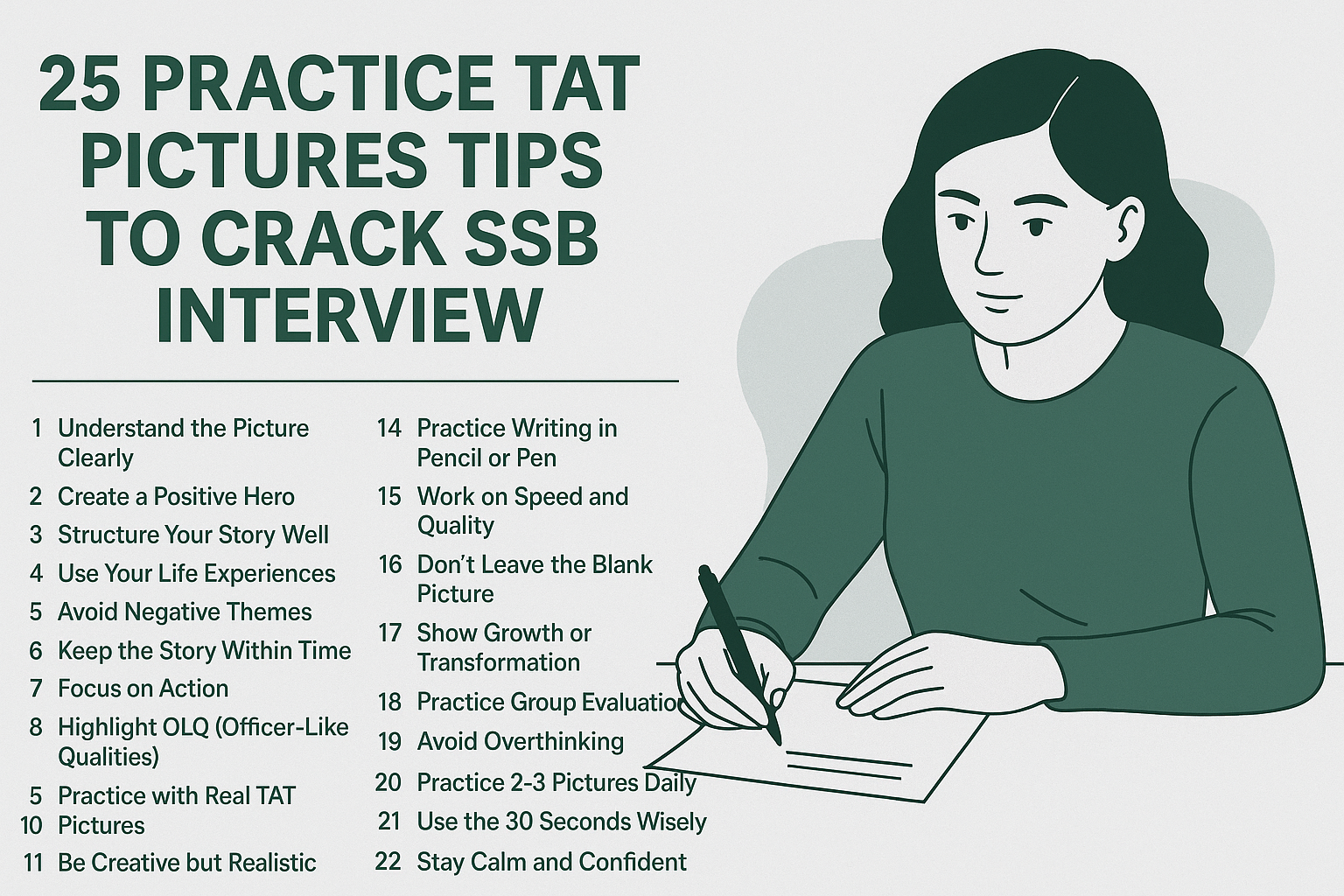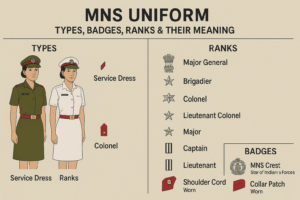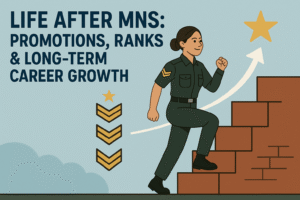What is TAT in SSB?
The Thematic Apperception Test (TAT) is conducted on Day 2 of the SSB Interview under the Psychological Tests. In this test:
You are shown 12 pictures (including one blank slide).
Each picture is displayed for 30 seconds.
You get 4 minutes to write a story.
The objective is to assess your thought clarity, originality, attitude, and personality traits like leadership, responsibility, empathy, and decision-making.
25 Practical TAT Picture Writing Tips
1. Understand the Picture Clearly
Don’t rush. Observe the background, number of characters, their actions, emotions, and the setting. Form a logical framework before writing.
2. Create a Positive Hero
Every story should revolve around a central character (preferably of your age and gender) who solves a problem or contributes positively.
3. Structure Your Story Well
Follow a basic flow: Situation ➜ Problem ➜ Action ➜ Result ➜ Conclusion.
4. Use Your Life Experiences
Incorporate realistic elements from your own experiences to make your stories more authentic and relatable.
5. Avoid Negative Themes
Stay away from overly emotional, tragic, or violent endings. SSB looks for emotionally stable and practical minds.
6. Keep the Story Within Time
You get only 4 minutes. Practice writing crisp, to-the-point stories within the time limit.
7. Focus on Action
Your hero should take active steps. Avoid passive characters. Highlight efforts, planning, and execution.
8. Highlight OLQ (Officer-Like Qualities)
Showcase traits like leadership, empathy, courage, cooperation, problem-solving, and social responsibility subtly in your story.
9. Practice with Real TAT Pictures
Use actual sample TAT images or sketch general scenes involving people at work, students, accidents, teams, etc.
10. Be Creative but Realistic
Avoid fantasy or exaggerated outcomes. Keep your story grounded in reality with believable endings.
11. Avoid Stereotypes
Don’t write typical ‘NCC cadet helps villagers’ in every story. Bring variety and originality.
12. Don’t Repeat Ideas
Every story should be unique and not sound repetitive.
13. Use Simple Language
Your language should be clear, error-free, and easy to understand. Don’t try to impress with jargon.
14. Practice Writing in Pencil or Pen
Simulate the real test environment. Writing with a pencil helps if you want to make quick changes.
15. Work on Speed and Quality
Initially focus on building ideas, then gradually increase writing speed without compromising quality.
16. Don’t Leave the Blank Picture
For the blank slide, prepare a story in advance but make it flexible. It could be your life goal or a situation you want to lead.
17. Show Growth or Transformation
End the story with a learning or positive change in the protagonist.
18. Practice Group Evaluation
Have a mentor or peer review your stories to point out inconsistencies or areas of improvement.
19. Avoid Overthinking
Don’t try to analyze what the assessor wants. Just write what you naturally perceive with a logical flow.
20. Practice 2–3 Pictures Daily
Consistency matters. Writing daily keeps your mind active and tuned to interpret visuals quickly.
21. Use the 30 Seconds Wisely
While the picture is on screen, mentally outline the story. Don’t just look—think.
22. Stay Calm and Confident
Avoid anxiety. Mental clarity improves story flow. Breathe deeply and focus.
23. Create a Story Bank
Maintain a notebook with well-written stories based on different themes—disaster management, student life, teamwork, leadership, etc.
24. Don’t Memorize Stories
Use your story bank only for idea generation, not rote learning. SSB values originality.
25. Analyze Post-Practice
After writing each story, evaluate:
Is it practical?
Does it show OLQs?
Is the ending realistic and positive?
Example TAT Practice Story
Picture Description: A boy is seen standing near a broken bridge, watching people on the other side.
Sample Story:
Rohit, a 21-year-old civil engineering student, was visiting a village for a college project. He noticed that the only bridge connecting the village to the town was damaged. He clicked pictures and documented the impact on daily life. Back at college, he presented the issue to the municipal body and offered a low-cost, temporary bridge solution. Within a month, the village got its connectivity restored. Rohit was appreciated for his proactive approach and commitment.
Officer-Like Qualities Reflected: Initiative, Responsibility, Civic Sense, Problem-Solving.
FAQs on TAT in SSB Interview
Q1. How many TAT pictures are shown in the SSB Interview?
You will be shown 12 pictures, including one blank slide.
Q2. How much time is given for each picture?
30 seconds to observe and 4 minutes to write the story.
Q3. Is it okay if I cannot write a story on a picture?
Avoid skipping. Try to write something even if basic. The assessor checks consistency.
Q4. What should I write for the blank picture?
You can prepare a story around your personal goals, a challenge overcome, or a situation where you led an initiative.
Q5. How can I improve in TAT?
Practice regularly, observe your surroundings, and work on time-bound story writing with a focus on OLQs.
Final Thoughts
TAT is not about writing fancy or emotional stories—it’s about reflecting your natural thinking pattern under pressure. Regular practice, a calm mind, and a positive attitude can make a big difference. Follow these 25 tips and turn each picture into a canvas of your officer-like personality.






